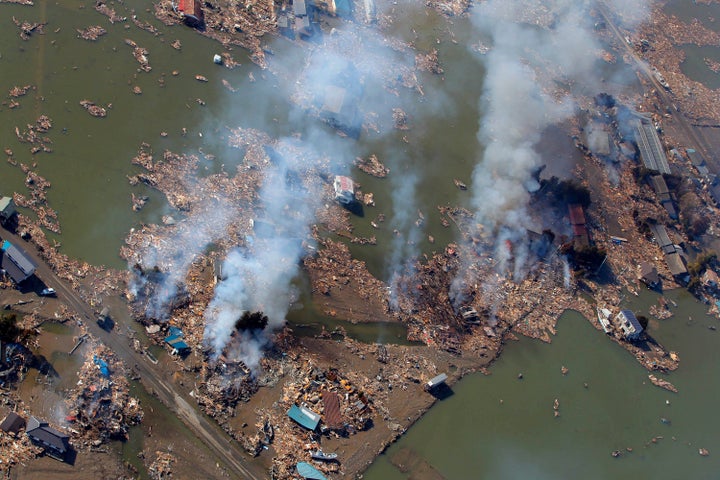
The calamitous Japanese earthquake and tsunami -- with the reluctant official admissions of possible reactor core meltdowns -- is a tragic reminder of the nuclear history of the Japanese people. Japan was the victim of U.S. atomic bomb attacks in 1945 at Hiroshima and Nagasaki -- the only country to have nuclear weapons used against it. It has since become the world's third largest nuclear energy power with 55 reactors on its small island land mass, most of them located in vulnerable coastal areas.
The nuclearization of Japan was not accepted uncritically. As part of my participation in the first United Nations Special Session on Disarmament, I was invited for a speaking tour by a Japanese interfaith coalition in 1979. By chance, my journey occurred shortly after the Three Mile Island nuclear accident in the US. My hosts urged me to make the connections between nuclear weapons and energy in my presentations because of the Japan's unique history.
One memorable meeting took place in the coastal town of Iwanai set amidst gorgeous mountains and cherry blossoms. A nuclear plant was scheduled to be built there. We met at the fishing cooperative with fishermen and local people who had been opposing the plant's construction for ten years.
After my presentation, Dr. Watanabe, a soft-spoken nuclear physicist, painted a grim picture of the potential impact of a plant only 6 km from the coastal town of 20,000 and its threat to local fishing. The reactor has since been constructed.
While this particular reactor has not been affected by the recent earthquake, we must look hard at the massive risks posed by nuclear energy. Meltdowns still in progress have already taken place in several sites along with serious explosions.
Add to this the potential radiation exposure from constant poisonous emissions into the atmosphere. Several hundred cases of nuclear contaminations have been admitted to thus far. A US naval plane tested radiation sixty miles off the Japanese coast and this windborne plague could reach our own shores. Also the disruption of massive population evacuations that are taking place around the plants should not be minimized. These men, women and children may not be able to return safely to their contaminated home for months or even years as was demonstrated in Chernobyl. Once again the Japanese people are being made the unwilling witnesses to the multiple dangers of nuclear technology.
One should not place too much confidence in the reports, predictions and numerical estimates by (watch their eyes) government and corporate experts and spokespeople. The major nuclear incidents at Three Mile Island, Chernobyl and the 2007 Japanese earthquake all have in common a pattern of denial, minimization and outright lies. This tradition goes all the way back to the post-World War II period when the US army of occupation in Japan under General MacArthur did its best to keep the results of studies and experiments about the atomic bombing from the Japanese victims themselves.
On my visits to Japan, I also had tearful meetings with the Hibakushas, the atom bomb survivors, in Hiroshima and Nagasaki. They are dying off now, both from old age and radiation cancers and other afflictions, but they leave behind children and grandchildren with genetic radiation sickness. They pleaded with me to tell their story to the world.
This experience was brought to mind by the recent report of the New York Academy of Science on the Chernobyl nuclear disaster, which documents 985,000 deaths and the effects of the poisonous radiation that covered the whole Northern Hemisphere.
We can't overlook the role of nuclear power plants in leading to the proliferation of nuclear weapons. This was how India joined the nuclear club in 1974. We know that overcrowded waste storage facilities are becoming more vulnerable to terrorists. Then we read an EPA report stating that stored nuclear waste remains radioactive for up to a million years.
U.S. Energy Secretary Steven Chu (himself a nuclear physicist) recently predicted "a clean energy future" through nuclear power. His prediction becomes more troubling in light of these recent disasters. Also, President Obama's support for a $36 billion loan guarantee (compliments of the tax payer) to the nuclear industry because Wall Street no longer bankrolls this unpromising project is part of this failed policy. Let us listen instead to the warning of the Japanese experience against this dangerous Faustian bargain and pursue the alternative of an authentic clean energy future with wind, sun and geothermal energy while there is still time.
As we witness the suffering of the people of Japan during the coming days, the saying on the cenotaph at Hiroshima should at least give us pause:
"The sin must not be repeated!"
A full account of Father Paul Mayer's experience in Japan and work with the Hibakushas appear in his recently completed Wrestling with Angels: A Spiritual Memoir of a Political Life.